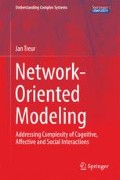Abstract
When persons function in a social context they interact with a number of other persons they know. These persons themselves also interact with a number of persons. And so on and on. When each person is modeled by a node and for each of these interactions arcs between the nodes are drawn, this results in a social network model, sometimes also called a social network ; for example, as shown in Fig. 11.1. Note that as such arcs indicate that interaction takes place, and interaction in principle means that persons affect each other, from a dynamical perspective they can also be considered relations that represent mutual causal effects on certain mental states of persons.
Access this chapter
Tax calculation will be finalised at checkout
Purchases are for personal use only
References
S. Aral, L. Muchnik, A. Sundararajan, Distinguishing influence based contagion from homophily driven diffusion in dynamic networks. Proc. Natl. Acad. Sci. (USA) 106(2), 1544–1549 (2009)
A.L. Barabási, R. Albert, Emergence of scaling in random networks. Science 286, 509–512 (1999)
R. Blankendaal, S. Parinussa, J. Treur, A temporal-causal modelling approach to integrated contagion and network change in social networks, in Proceedings of the 22nd European Conference on Artificial Intelligence, ECAI’16 (IOS Press, 2016)
S. Boccalettia, V. Latorab, Y. Morenod, M. Chavez, D.-U. Hwanga, Complex networks: structure and dynamics. Phys. Rep. 424(2006), 175–308 (2006)
T. Bosse, R. Duell, Z.A. Memon, J. Treur, C.N. van der Wal, Agent-based modelling of emotion contagion in groups. Cogn. Comput. J. 7(2015), 111–136 (2015)
D. Byrne, The attraction hypothesis: do similar attitudes affect anything? J. Personal. Soc. Psychol. 51(6), 1167–1170 (1986)
A. Clauset, C.R. Shalizi, M.E.J. Newman, Powerlaw distributions in empirical data. SIAM Rev. 51(4), 661–703 (2009)
E. Gilbert, K. Karahalios, Predicting tie strength with social media, in Proceedings of the SIGCHI Conference on Human Factors in Computing Systems, CHI’09, pp. 211–220 (2009)
J. Giles, Computational social science: making the links. Nature 488, 448–450 (2012)
M.S. Granovetter, The strength of weak ties. Amer. J. Sociol. 78(6), 1360–1380 (1973)
M. Granovetter, The strength of weak ties: a network theory revisited. Sociol. Theory 1(1983), 201–233 (1983)
J.H.B. de Groot, M.A.M. Smeets, A. Kaldewaij, M.J.A. Duijndam, G.R. Semin, Chemosignals communicate human emotions. Psychol. Sci. 23(11), 1417–1424 (2012). doi:10.1177/0956797612445317
M.J. Hove, J.L. Risen, It’s all in the timing: interpersonal synchrony increases affiliation. Soc. Cognit. 27, 949–960. doi:10.1521/soco.2009.27.6.949 (2009)
D. Krackhardt, The strength of strong ties: the importance of philos in organizations, in Networks and Organizations: Structure, Form, and Action, ed. by N. Nohria, R. Eccles (Harvard Business School Press, Boston, MA, 1992), pp. 216–239
P.L. Krapivsky, S. Redner, F. Leyvraz, Connectivity of growing random networks. Phys. Rev. Lett. 85(21), 4629–4632 (2000)
P.L. Krapivsky, S. Redner, Organization of growing random networks Phys. Rev. E 63, 066123(14) (2001)
P.L. Krapivsky, S. Redner, Rate equation approach for growing networks, in Statistical Mechanics of Complex Networks, vol. 625, Lecture Notes in Physics, ed. by R. Pastor-Satorras, M. Rubi, A. Diaz-Guilera (2003) pp. 3–22
P.V. Marsden, K.E. Campbell, Measuring tie strength. Soc. Forces 63(1990), 482–501 (1990)
M. McPherson, L. Smith-Lovin, J.M. Cook, Birds of a feather: homophily in social networks. Annu. Rev. Sociol. 27, 415–444 (2001)
A. Mislove, B. Viswanath, K.P. Gummadi, P. Druschel, You are who You know: inferring user profiles in online social networks, in Proceedings of the WSDM’10, February 4–6, 2010, New York City, New York, USA, pp. 251–260 (2010)
M.R. Morris, J. Teevan, K. Panovich, What Do People Ask Their Social Networks, and Why? A Survey Study of Status Message Q&A Behavior. CHI 2010 (2010)
M.P. Mundt, L. Mercken, L.I. Zakletskaia, Peer selection and influence effects on adolescent alcohol use: a stochastic actor-based model. BMC Pediatrics 12, 115 (2012)
M.E.J. Newman, The structure and function of complex networks. SIAM Rev. 45, 167–256 (2003)
H.V.D. Parunak, E. Downs, A. Yinger, Socially-constrained exogenously-driven opinion dynamics, in Fifth International, IEEE Conference Self-Adaptive and Self-Organizing Systems (SASO) (2011)
E. Pearce, J. Launay, R.I.M. Dunbar, The ice-breaker effect: singing together mediates fast social bonding. R. Soc. Open Sci. (2015). doi:10.1098/rsos.150221
S. Perseguers, M. Lewenstein, A. Acín, J.I. Cirac, Quantum random networks. Nat. Phys. 6, 539–543 (2010)
D.J. de S. Price, A general theory of bibliometric and other cumulative advantage processes, J. Amer. Soc. Inform. Sci. 27, 292–306 (1976)
A. Rapoport, Contribution to the theory of random and biased nets. Bull. Math. Biol. 19, 257–277 (1957)
C.R. Shalizi, A.C. Thomas, Homophily and contagion are generically confounded in observational social network studies. Sociol. Methods Res. 40(2), 211–239 (2011)
A. Sharpanskykh, J. Treur, Modelling and analysis of social contagion in dynamic networks. Neurocomput. J. 146(2014), 140–150 (2014)
C.E.G. Steglich, T.A.B. Snijders, M. Pearson, Dynamic networks and behavior: separating selection from influence. Sociol. Methodol. 40, 329–393 (2010)
T.W. Valente, Social Networks and Health: Models, Methods, and Applications (Oxford University Press, New York, 2010)
T.W. Valente, Network interventions. Science 337(49–53), 2012 (2012)
W. van Breda, J. Treur, A. van Wissen, Analysis and support of lifestyle via emotions using social media, in Proceedings of the 4th International Conference on Social Informatics, SocInfo’12, Lecture Notes in Computer Science (Springer, 2012), pp. 275–291
Author information
Authors and Affiliations
Corresponding author
Rights and permissions
Copyright information
© 2016 Springer International Publishing Switzerland
About this chapter
Cite this chapter
Treur, J. (2016). Changing Yourself, Changing the Other, or Changing Your Connection. In: Network-Oriented Modeling. Understanding Complex Systems. Springer, Cham. https://doi.org/10.1007/978-3-319-45213-5_11
Download citation
DOI: https://doi.org/10.1007/978-3-319-45213-5_11
Published:
Publisher Name: Springer, Cham
Print ISBN: 978-3-319-45211-1
Online ISBN: 978-3-319-45213-5
eBook Packages: Physics and AstronomyPhysics and Astronomy (R0)

